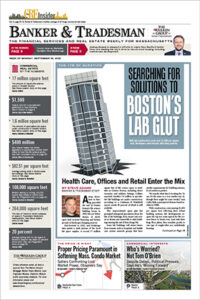Under the leadership of an executive with plenty of big bank experience, Belmont Savings Bank’s marketing team is trying aggressively to steal customers from the national players. And results so far indicate success.
“We’ve seen 20 percent customer growth, and they’re all coming from the big banks,” said Hal Tovin, Belmont Savings’ executive vice president and COO.
The bank, which became a stock bank just last year, reported $493.5 million in total deposits at the end of the first quarter. That’s an increase of $62.9 million, or 14.6 percent, from the end of 2011.
Tovin previously ran marketing at Providence, R.I.-based Citizens Bank. He knows that customers don’t usually switch banks on a whim, and he’s brought a fun but aggressive strategy to Belmont Savings to help it take customers from its much larger competitors.
In order for a customer to switch banks, either “something happens,” a divorce, for example, “or their bank annoys them,” Tovin told Banker & Tradesman.
And with big-bank annoyance seemingly at a high, Belmont decided to strike. And it’s not waiting for frustration, or any life events, to convince customers to make a change.
Spend To Earn
A series of three Belmont Savings television ads began airing recently. In addition to promising not to charge ATM fees and to be able to switch a customer’s accounts to Belmont Savings from a competitor in an hour, the ads also take the opportunity to poke the much larger competition.
In each ad, “Big Bank” is represented by a logo and color scheme, ahem, “reminiscent of big banks,” Tovin said. They are, in fact, easily recognizable as stand-ins for Bank of America, TD Bank and Sovereign Bank.
“We can deliver the same products and services as any big bank, and you’ve seen what’s going on in banking today,” Tovin said. “At our bank, you can still get to people; we’ve avoided the automated phone route. It’s still a pain in the neck to switch banks, so we made it fun with the ‘switch kit.’”
But there’s more to it than fun stuff. Putting timers on associates’ desks, and offering potential customers $60 if the bank can’t switch their accounts to Belmont Savings in an hour is fine – but the bank still has to get those folks in the door in the first place.
“I think you’ll see a pattern that a lot of community banks have ramped up their marketing budgets and their marketing programs, not only to take advantage of people who are not happy with those [big bank] relationships, but to secure as much business as possible in this environment,” East Boston Savings Bank President and CEO Richard Gavegnano told Banker & Tradesman.
East Boston Savings Bank, a $2 billion institution based in Peabody, spent $559,000 on marketing in the first quarter, compared to $541,000 a year prior.
“Everyone’s in the same boat trying to do more business. The regulatory environment that we’re in means we have to establish we’re a better bank to do business with,” Gavegnano said.
As of the end of the first quarter, $718 million Belmont Savings spent $239,000 on marketing compared to $222,000 in the same period a year earlier, according to company filings.
“We probably spend more on marketing than a lot of other banks,” Tovin said.
However, it is not alone in spending a considerable chunk of change on keeping its name in the public eye.
Knowing What They’re Getting
As of the end of the first quarter, the $1.3 billion Cambridge Trust Co. spent $438,000 on marketing, flat with the same quarter a year earlier.
Jane Lundquist, executive vice president at the $5 billion Rockland Trust Co., told Banker & Tradesman the bank is also making a big marketing push, but she wouldn’t share the “spend” involved.
Rockland’s latest television ad campaign started in May. It is also stepping up its print, radio and – this summer – billboard campaigns.
“And we’ll be doing a lot of TV advertising this summer throughout the Olympics, and you’ll probably see our ad during the (Major League Baseball) All Star game,” Lundquist said. “What we’ve been seeing is not that the smaller banks are offering something special to get customers to switch. It starts with the customers having a poor experience and high fees at the very large banks. It’s more the customer saying they’re ready to make a change.”
In fact, Rockland surveys new customers, and has found that almost half switched to Rockland on the recommendation of family and friends, Lundquist said, but they’ll take care of transferring accounts themselves.
“We’ve been trying to get the Rockland Trust name out in the market… everyone says they have great service. Anecdotally, we are seeing a lot of customers who are coming from the larger institutions in the area,” she continued. “Once people have decided they are ready for a change, a lot of people are looking for convenience, and it’s in the digital channel. Having all the pieces and convenience is really critical.”
The move by customers from very big banks to local banks is not unlike the flight highly touted by the credit union industry in recent months.
“We’ve seen the same trends they’ve seen,” Tovin said. “We were hearing the same things they were hearing. People were fed up. We have fees, too, but we have more options and more benefits. When people understand what they’re getting, they’re happier, and that’s the problem with big banks; (customers) don’t know what they are getting.”






